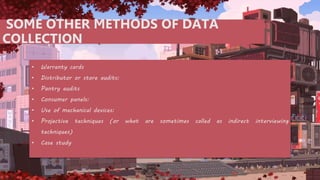This document discusses various methods of data collection that researchers use in studies, including observation, interviews, questionnaires, and archival data. It provides details on the different types of observation (controlled, participant), interviews (structured, semi-structured, unstructured), and considerations for each method. The document also outlines questionnaires as a method and considerations like response rates. Overall, the document serves as an overview of common data collection methods, their uses, and factors to consider like reliability, validity, and biases.















![BILBOGRAP
Y
• [C.R._Kothari]_Research_Methodology__Methods_and_T
• INTRODUCTION_TO_RESEARCH_
• IGNOU_BA_PSYCHOLOGY_STUDYMATERIAL_
• www.scribbr.com/methodology/interviews-research.
• www.mbaknol.com/research-methodology/
• APA](https://image.slidesharecdn.com/methodsofdatacollection-230125081220-8f7178a0/85/Methods-of-Data-Collection-pptx-16-320.jpg)
